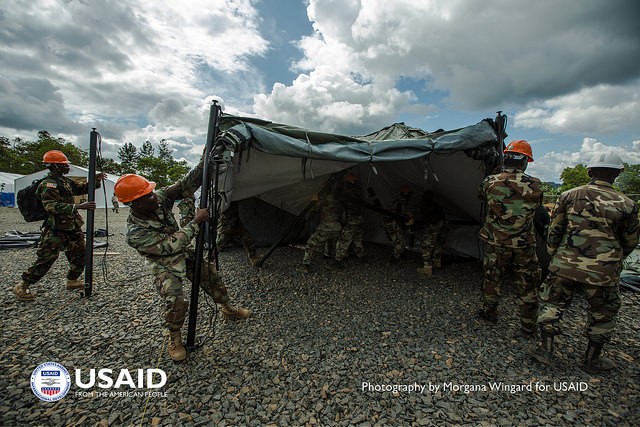
For Immediate Release
TUBMANBURG, Monrovia - The first Ebola treatment unit (ETU) built and staffed with U.S. Government funding is prepared to receive its first patients this week. ETU construction was overseen by the U.S. Department of Defense working with the Armed Forces of Liberia, which was a vital partner in the building process. The U.S. Agency for International Development (USAID) is funding the management and clinical care of the ETU, which will be provided by the International Organization for Migration (IOM) under the leadership of the Liberian Ministry of Health and Social Welfare. Including this ETU, critical funding support from the United States has helped increase the number of Ebola treatment units in Liberia to eight.
"USAID is coordinating an aggressive, whole-of-government response to stop and contain the spread of Ebola in West Africa," said USAID Administrator Rajiv Shah. "We are starting to see early signs of progress, but we must continue to build the pace, ingenuity and scale of our response. Working with partners like IOM ensures ETUs are staffed with trained medical personnel, which is critical to breaking the cycle of transmission. The health care workers, humanitarians and local community leaders working on the frontline of this effort are saving lives and making a difference every day, and deserve our gratitude."
For the past two weeks, IOM's medical team-made up of local and international healthcare workers-received rigorous training on Ebola patient care, safety protocols, and ETU management. Part of the training included time spent in an operational ETU. IOM will also be working closely with the Liberian government to operate U.S.-built ETUs in Buchanan, Liberia's third largest city, and Sinje. In addition to the ETUs constructed and operated by USAID international and non-governmental partners, the Department of Defense is in the process of building and supporting up to 17 ETUs, including the three which will be operated by IOM.
Since the first cases of Ebola were reported in West Africa in March 2014, the United States has moved quickly to contain and ultimately stop the epidemic. In addition to support for ETUs, U.S. support to date has provided training for hundreds of healthcare workers; expanded the pipeline of medical supplies and personnel to the region; supported the 65 safe burial teams now working in every county in Liberia; helped to more than double the lab capacity in Liberia; and supported aggressive social change and Ebola education campaigns.
There are currently more than 2,100 U.S. civilian and military personnel in West Africa, including a Disaster Assistance Response Team deployed by USAID to oversee overall Ebola response efforts, making this the largest-ever U.S. response to a global health crisis.







Comment
Make a general inquiry or suggest an improvement.